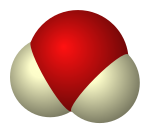
Back Swaarwater Afrikaans ماء ثقيل Arabic Agua pesao AST Ağır su Azerbaijani آغیر سو AZB Цяжкая вада Byelorussian Цяжкая вада BE-X-OLD Тежка вода Bulgarian ভারী পানি Bengali/Bangla Aigua pesant Catalan
| |||
| Names | |||
|---|---|---|---|
| IUPAC name
(2H2)Water[4]
| |||
| Other names | |||
| Identifiers | |||
3D model (JSmol)
|
|||
| ChEBI | |||
| ChEMBL | |||
| ChemSpider | |||
| ECHA InfoCard | 100.029.226 | ||
| EC Number |
| ||
| 97 | |||
| KEGG | |||
| MeSH | Deuterium+Oxide | ||
PubChem CID
|
|||
| RTECS number |
| ||
| UNII | |||
CompTox Dashboard (EPA)
|
|||
| |||
| |||
| Properties | |||
| D 2O | |||
| Molar mass | 20.0276 g mol−1 | ||
| Appearance | Colorless liquid | ||
| Odor | Odorless | ||
| Density | 1.107 g mL−1 | ||
| Melting point | 3.82 °C; 38.88 °F; 276.97 K | ||
| Boiling point | 101.4 °C (214.5 °F; 374.5 K) | ||
| Miscible | |||
| log P | −1.38 | ||
Refractive index (nD)
|
1.328 | ||
| Viscosity | 1.25 mPa s (at 20 °C) | ||
| 1.87 D | |||
| Hazards | |||
| NFPA 704 (fire diamond) | |||
Except where otherwise noted, data are given for materials in their standard state (at 25 °C [77 °F], 100 kPa).
| |||
Heavy water (deuterium oxide, 2
H
2O, D
2O) is a form of water in which hydrogen atoms are all deuterium (2
H or D, also known as heavy hydrogen) rather than the common hydrogen-1 isotope (1
H, also called protium) that makes up most of the hydrogen in normal water.[3] The presence of the heavier isotope gives the water different nuclear properties, and the increase in mass gives it slightly different physical and chemical properties when compared to normal water.
Deuterium is a heavy hydrogen isotope. Heavy water contains deuterium atoms and is used in nuclear reactors. Semiheavy water (HDO) is more common than pure heavy water, while heavy-oxygen water is denser but lacks unique properties. Tritiated water is radioactive due to tritium content.
Heavy water has different physical properties from regular water, such as being 10.6% denser and having a higher melting point. Heavy water is less dissociated at a given temperature, and it does not have the slightly blue color of regular water. It can taste slightly sweeter than regular water, though not to a significant degree. Heavy water affects biological systems by altering enzymes, hydrogen bonds, and cell division in eukaryotes. It can be lethal to multicellular organisms at concentrations over 50%. However, some prokaryotes like bacteria can survive in a heavy hydrogen environment. Heavy water can be toxic to humans, but a large amount would be needed for poisoning to occur.
The most cost-effective process for producing heavy water is the Girdler sulfide process. Heavy water is used in various industries and is sold in different grades of purity. Some of its applications include nuclear magnetic resonance, infrared spectroscopy, neutron moderation, neutrino detection, metabolic rate testing, neutron capture therapy, and the production of radioactive materials such as plutonium and tritium.
- ^ Parpart, Arthur K. (December 1935). "The permeability of the mammalian erythrocyte to deuterium oxide (heavy water)". Journal of Cellular and Comparative Physiology. 7 (2): 153–162. doi:10.1002/jcp.1030070202.
- ^ Svishchev, I. M.; Kusalik, P. G. (January 1994). "Dynamics in liquid water, water-d2, and water-t2: a comparative simulation study". The Journal of Physical Chemistry. 98 (3): 728–733. doi:10.1021/j100054a002.
- ^ a b PubChem. "Deuterium oxide". pubchem.ncbi.nlm.nih.gov. Retrieved 22 April 2021.
- ^ International Union of Pure and Applied Chemistry (2005). Nomenclature of Inorganic Chemistry (IUPAC Recommendations 2005). Cambridge (UK): RSC–IUPAC. ISBN 0-85404-438-8. p. 306. Electronic version.


